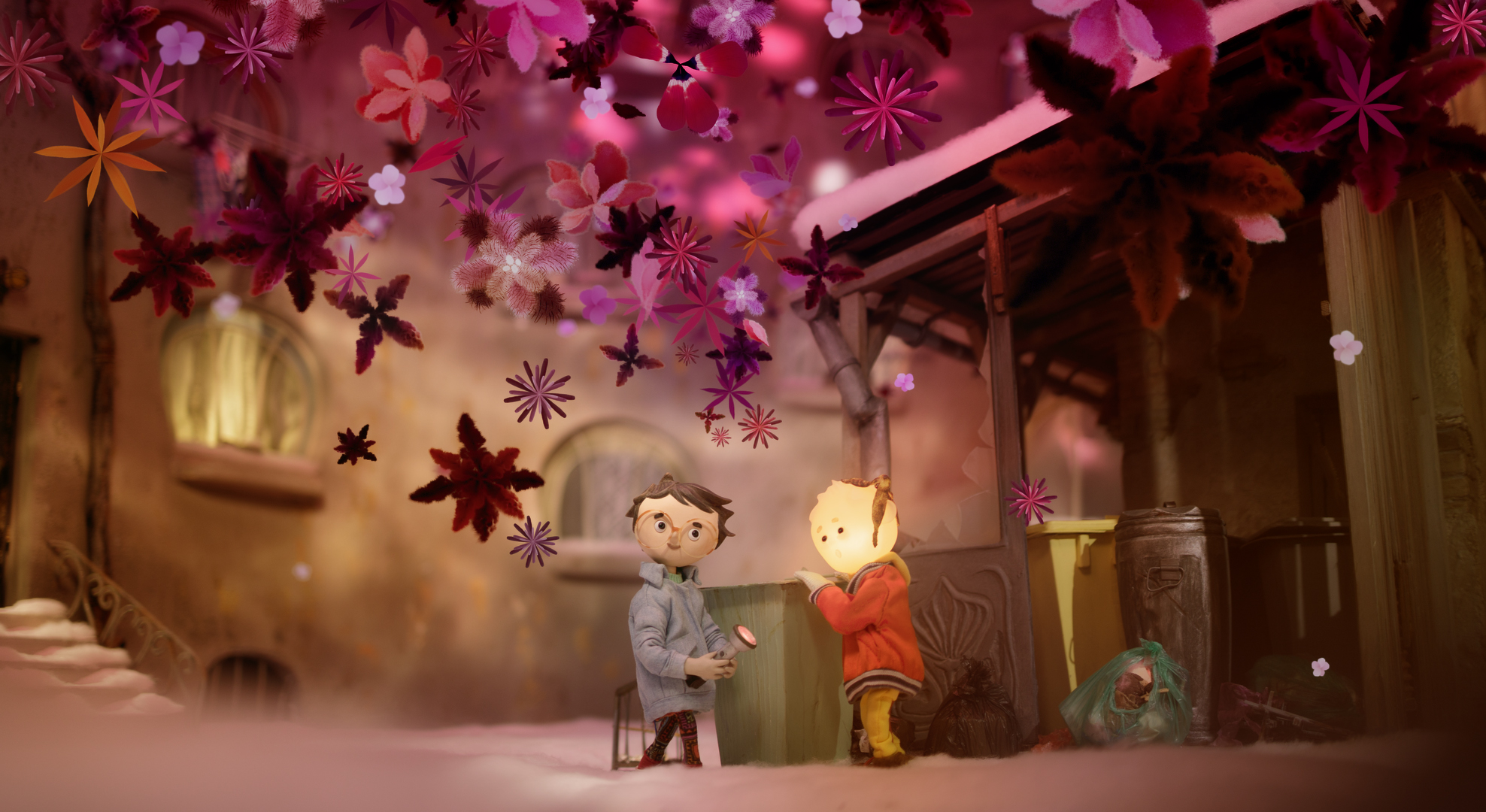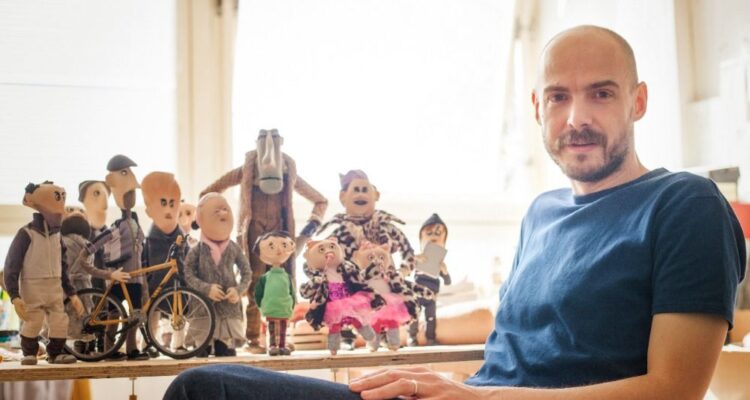Nachdem er mehrere Kurzfilme drehte und auch an einer Webserie arbeitete, legte Filip Pošivac 2023 seinen ersten Langfilm vor. In dem Stop-Motion-Abenteuer Tony, Shelly und das magische Licht erzählt er die Geschichte des Jungen Tony, der eine ganz besondere Fähigkeit hat: Er leuchtet. Seine Eltern sind deswegen immer besorgt, dass er gehänselt werden könnte und lassen ihn deshalb nicht aus dem Haus, drängen ihn zudem dazu, sich ständig zu verhüllen. Glücklich ist er nicht darüber. Tatsächlich ist er sogar ziemlich einsam, bis er eines Tages Shelly kennenlernt, die mit ihrer Mutter ins Mehrfamilienhaus einzieht und eine besondere Taschenlampe hat, mit der sie Fantasiewelten erschaffen kann. Wir haben uns anlässlich des Kinostarts am 7. November 2024 mit dem tschechischen Regisseur über die Arbeit an seinem Film, seine Einflüsse und Hoffnung gesprochen.
Kannst du uns etwas über die Entwicklung des Films erzählen? Wie begann dieses ganze Projekt?
Von der ersten Idee bis zur Kinopremiere vergingen fast acht Jahre. In den ersten drei Jahren arbeiteten wir am Drehbuch, am Budget für die Entwicklung und an der Vorproduktion. Im Jahr 2019 begannen wir mit den Dreharbeiten in Prag. Und dann folgte ein Jahr Postproduktion wie Musik und Ton. Ich bin es gewohnt, in kleinen Teams mit vier oder fünf Leuten zu arbeiten. Aber als wir drehten, waren es etwa dreißig Leute.
War es schwierig, so viele Leute für das Team zu finden?
Nein, nicht wirklich. Ich habe Stop-Motion an der Universität studiert. Unsere Professoren waren Jan Balej und Jiří Barta, zwei hervorragende Schöpfer von Stop-Motion-Filmen und Animationen. Ich hatte also viel Erfahrung mit diesen Techniken und kannte ein paar sehr fähige Leute, die ich bitten konnte, mit mir zusammenzuarbeiten.
Warum hast du für den Film Stop-Motion anstelle einer anderen Animationstechnik verwendet?
Ich denke, dass es immer auf den Charakter des Drehbuchs und der Geschichte ankommt. In Tony, Shelly und das magische Licht geht es sowohl auf metaphorischer als auch auf praktisch-dramatischer Ebene um Dunkelheit und Licht. Stop-Motion ist eine sehr schöne Technologie, bei der man mit Beleuchtung und mit der Kamera arbeiten kann. Ich hatte das Gefühl, dass diese Geschichte eine sehr reale Geschichte mit echten Emotionen und echten Charakteren ist, und auf der anderen Seite gibt es viel Fantasie, die fast greifbar ist. Das ist der Grund, warum ich mich für diese Technik entschieden habe. Es kommt also wirklich auf den Film an. Ich arbeite zum Beispiel gerade an einem anderen Drehbuch, in dem es um die Fragilität von Beziehungen geht. Und ich habe mich für eine völlig andere Technologie entschieden, nämlich eine Kombination aus Malerei und Animation.
Du hast bereits zwei wichtige tschechische Animatoren erwähnt. Und natürlich hat Stop-Motion in deinem Land eine lange Tradition. Fühlst du dich von dieser Geschichte beeinflusst?
Ich denke, dass dieser Einfluss an den Kunstuniversitäten, an denen man Animation studieren kann, sehr stark ist, weil es ein grundlegender Teil der Geschichte der Kinematographie ist. Ich bin sicher, dass alle Studenten und alle Schöpfer die Wirkung von Jiří Trnka oder Jan Švankmajer spüren. Viele meiner Kollegen arbeiten in ganz unterschiedlichen Bereichen der Animation, aber ich persönlich mochte schon immer Puppentheater und Kunsthandwerk, bei dem man etwas mit den eigenen Händen erschaffen kann. Ich denke, ich bin sehr handwerklich. Tony, Shelly und das magische Licht war also ein wahrgewordener Traum, denn ich konnte alles ausprobieren, was ich schon immer ausprobieren wollte.
Wenn man Filmfestivals wie Annecy besucht, sieht man viele Stop-Motion-Filme. Dieses Jahr gab es dort beispielsweise Memoir of a Snail und Savages, die seither auf vielen anderen Festivals gezeigt werden. Ende des Jahres wird außerdem ein neuer Wallace & Gromit Film herauskommen. Hast du das Gefühl, dass Stop-Motion gerade eine Art Renaissance erlebt? Oder ist es einfach etwas, das nie wirklich verschwunden ist?
In der Tschechischen Republik spricht man manchmal von einer Renaissance. Aber ich denke, das ist ein Zufall, denn die Entwicklung von Stop-Motion-Projekten dauert sehr lange, sodass man nicht wirklich planen kann, dass diese Filme gleichzeitig herauskommen. Als ich unterwegs war, insbesondere mit Tony, Shelly und das magische Licht, spürte ich, dass Kinder um die 10 oder 11 Jahre überrascht waren, dass es sich bei dieser Technologie nicht um 3D handelte. Manchmal fragten sie mich, wie ich die Strukturen oder Spezialbewegungen gemacht habe. Und als ich antwortete, dass alles von Hand gemacht wird, waren sie sehr überrascht. Daher denke ich, dass diese ziemlich altmodische Technologie für junge Leute vielleicht etwas Neues wird.

Dann lassen Sie uns über den Film selbst und die Geschichte sprechen. Kannst du uns erzählen, wie du auf die Idee gekommen bist? Warum wolltest du die Geschichte erzählen?
Am Anfang hatte ich nur die Idee eines leuchtenden Jungen und eines Mädchens mit großer Brille, die Angst vor der Dunkelheit hat, und zusammen in einem dunklen Haus leben. Später entschloss ich mich, mit Jana Šrámková zusammenzuarbeiten, die eine sehr gute Autorin von Kinderbüchern ist. Ich hatte ein Buch illustriert, das sie geschrieben hatte. Sie ist voller Einfühlungsvermögen und denkt viel über ihre Charaktere nach. Also begannen wir gemeinsam mit der Entwicklung des ersten Drehbuchs. Und sehr bald wurden die Charaktere für uns wie echte Menschen, wie unsere Kinder oder Verwandten. Wir haben auch versucht, das Setting weiterzuentwickeln, indem wir uns an ähnlichen Orten trafen. Wir trafen uns zum Beispiel in einem alten botanischen Garten in Prag, um am Drehbuch zu arbeiten. Das ging zwei Jahre lang so und am Ende hatten wir eine sehr lange Version, weil wir ohne Grenzen schrieben. Nachdem wir die erste Fassung fertiggestellt hatten, begannen wir mit der Zusammenarbeit mit Dramaturgen.
Dann lass uns über die Dunkelheit reden. Ohne die spätere Geschichte zu verraten, erfahren wir, dass viele der Menschen in deinem Film auf irgendeine Weise unglücklich sind und dunkle Gefühle haben. Hast du das Gefühl, dass die Menschen heute hoffnungsloser sind als früher?
Das glaube ich nicht, nein. Aber ich denke, dass diese schlechten Dinge heute sichtbarer sind, weil wir soziale Netzwerke haben. Wir können Nachrichten jede Sekunde abrufen, wann immer wir wollen. Ich denke, dass es sehr einfach ist, schlechte Dinge zu sehen, wann immer man will. Das ist anders als früher, als wir Kinder waren, denn damals war es nicht so einfach, Zugang zu diesen schlechten Nachrichten zu bekommen. Ich persönlich bin kein wirklich optimistischer Mensch. Aber ich glaube immer, dass es eine Möglichkeit gibt, in der Dunkelheit etwas Gutes, etwas Helles zu finden. Du musst dieses Vertrauen haben. Sonst wirst du verrückt. Und ich habe große Hoffnung für die junge Generation, denn sie ist unsere Zukunft, solange wir sie als Partner behandeln und ernst nehmen und sie ihre eigenen Antworten finden lassen.
Hattest du deshalb diese Ambivalenz im Film? Die Menschen sind nicht nur gut oder böse. Dazwischen liegt einiges.
Ja, du hast recht. Jana sagt immer, dass es sehr gut ist, den Grund zu kennen, warum eine Figur böse ist, wenn man in einer Geschichte einen Antagonisten hat, egal ob es sich um ein Buch oder einen Film handelt. Wir alle haben unsere Gründe, warum wir uns so verhalten, wie wir es tun.
Ich mag die Idee dieser Taschenlampe wirklich, mit der man alles möglich machen und Welten erschaffen kann und so weiter. Wenn du diese magische Taschenlampe im wirklichen Leben hättest, was würdest du gerne erschaffen?
Ich denke, dass meine magische Taschenlampe meine Arbeit ist. Animationsfilme zu machen gibt mir die Möglichkeit, meine Ideen oder woanders zu projizieren. Daher denke ich, dass die Animation sehr gut mit der Taschenlampe übereinstimmt.
Du hast also nicht das Gefühl, etwas außerhalb des Films erschaffen zu müssen?
Eigentlich nicht, denn weißt du, ich habe keine anderen Hobbys. Ich habe immer gemalt und gezeichnet. Mein Problem ist also, dass ich jetzt das Gefühl habe, dass ich etwas anderes finden muss, denn wenn das Hobby zum Beruf wird, kann es ziemlich schwierig werden.
Warum wolltest du überhaupt Filmemacher werden?
Eigentlich wollte ich kein Filmemacher werden. Ich wollte Illustrator oder Maler werden, also habe ich darüber nachgedacht, an der Akademie der Schönen Künste zu studieren. Aber an der Prager Universität ist es sehr schwierig, die Aufnahmeprüfungen zu bestehen. Ein Freund schlug vor, es stattdessen mit Animation zu versuchen. Und als ich in diese Abteilung ging, gab es dort einen Bildschirm mit kurzen Animationen und ich hatte das Gefühl, dass es genau das ist, was ich tun möchte. Aber ich wollte damals kein Regisseur werden. Ich habe mich immer eher als Designer gefühlt. Mein Traum war es also, Layouts und Charaktere zu erstellen und die visuellen Elemente zu entwerfen. Aber als ich während meines Studiums versuchte, Dreharbeiten zu organisieren und mit anderen Leuten zusammenzuarbeiten, fing ich an, es sehr zu lieben. Es ist nicht nur der kreative Teil der Produktion, der mir gefällt. Ich arbeite außerdem sehr gerne im Team und kooperiere mit anderen Menschen. Jetzt genieße ich es, Regisseur zu sein, auch wenn ich nicht geplant hatte, einer zu werden.
Und was hoffst du als Filmemacher zu erreichen? Was erhoffst du von Tony, Shelly und das magische Licht für dein Publikum?
Das ist eine sehr gute Frage, denn das ist nicht die Art von Film, bei der man Kinder auf die Couch abstellen und dann gehen kannst. Ich freue mich immer sehr, wenn ich sehe, dass Familien kommen, um sich unseren Film anzusehen und über einige der Themen zu sprechen, die sie auf der Leinwand gesehen haben. Beziehungen zwischen Kindern und Eltern. Die Autonomie von Kindern. Freundschaft. Ich weiß, dass es wie ein Klischee klingt, aber diese Werte sind für unsere Gesellschaft sehr wichtig, deshalb macht es mich glücklich zu sehen, wenn das Publikum darüber nachdenkt.
Meine letzte Frage bezieht sich auf dein neues Projekt, das du erwähnt hast. Könntest du uns etwas mehr darüber erzählen?
Es ist ein Spielfilm für Familien. Es spielt in einem See und handelt von Axolotls. Da sie vom Aussterben bedroht sind, sind die erwachsenen Tiere sehr beschäftigt, ihre Art zu retten. Dies bedeutet jedoch, dass sie keine Zeit für ihre Kinder haben und nicht kommunizieren, was zu Problemen führt. Es wird also ein Film über die Beziehungen zwischen Erwachsenen und Kindern sein, umgesetzt als Kombination aus 2D- und 3D-Technologie.
Vielen Dank für das Gespräch!
(Anzeige)

